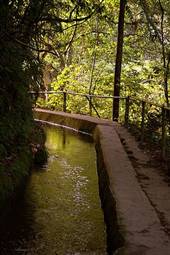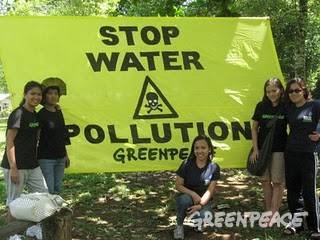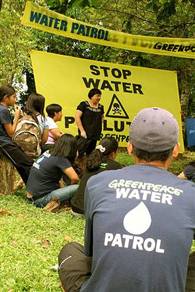 |
| Reflection of the vegetation on irrigation water from Mount Banahaw. |
The world celebrates World Water Day every March 22.
This year, some 50 members of the Greenpeace Water Patrol went to Majayjay to document the beauty of Mt. Banahaw and the waters that spring from it as part of Project Clean Water’s activities.
The Taytay Falls in Majayjay is the 7th of a series of Falls that form the Dalitiwan River which eventually joins the Pagsanjan and Sta. Cruz Rivers, the two largest tributaries of the Laguna Lake. We were there to highlight the need to urgently protect the remaining clean waters from contamination. The Majayjay waters are especially significant since it is one of the few remaining clean waters within the Laguna Lake Water Basin.
We grouped ourselves into 2 teams. The first team went deeper into the forest, an area not normally open to the general public but was accessed with a guide and special permission from the Barangay and the local DENR. A second team stayed around the Falls and the surrounding community to conduct interviews with campers and members of the community.
 |
| Click on the image to read Irene Rafer’s blog about the documentation |
I was unable to go higher than the Taytay Falls because I had to make sure I was around to receive special guests which included Mayor Victorino Rodillas of the Municipality of Majayjay, Barangay Captain Pio Royo of Barangay Taytay, Ms. Marlene Tamolang of the Community Environment and Natural Resources Office and Ms. Pinky Villaseñor of the Laguna Youth Development Affairs Office. But according to those who did, it was spectacular up there. The pools of water were crystal clear and so refreshingly beautiful.
As we trekked to the Falls and the Dalitiwan River, I happily noted that the waters had remained clear despite the increase in tourists. Even the water that was being rechanneled for irrigation was clear although there were a few plastic wastes here and there. The vegetation was thick and the diversity was rich. Water was just dripping from the mountain’s walls. The ambient air temperature was distinctly colder than when I was out in the clearing.
On the way, we saw some kingfishers and sunbirds, different varieties of trees and flowers. We also saw clusters of Jade Vine flowers (Strongylodon macrobotrys), a Philippine tropical plant that is listed as an endangered species. I smiled thinking that this trip was going to be promising.
According to Beau, Baconguis,Greenpeace SEA Toxics Campaigner, the waters of Majayjay are touted to be one of the cleanest in the Laguna Lake Water Basin as it passes through the thick forests of Mt. Banahaw that act as a natural filtration system. These waters fall within the Mt.Banahaw-San Cristobal Protected Landscape. This protected area is also extremely rich in biological diversity. In lieu of this I based my photo essay on the pristine beauty of the falls and how the tourists treat it.
Click here to view AC Dimatatac’s photo essay on World Water Day 2009
But as we drew closer to the Falls, the loud sound of camper chatter and music broke the solitude of the trek. Then we started seeing more and more people and more and more wastes. When we got there, the place was packed with campers and day visitors. While the water looked clear, tourist wastes were strewn all over. We also saw people using shampoo and soap to bathe, washing greasy plates with detergent, etc. I was saddened at the sight because I know, if this continues, irresponsible tourists will eventually kill these waters. I was told that around Holy Week, the tourist numbers in the Falls reach about 15,000. That’s way too many people for this area.
We spoke to the government officials who came and shared with them our views on the management of this place. A good briefing for visitors must be conducted before they are allowed to enter the park. There has to be some strong enforcement of protected area laws and stiffer penalties for violations. There should also be a limit to how many visitors can enter the park and it should be based on the carrying capacity of this ecosystem.
 |
| : Local DENR official discusses management of Mt. Banahaw Protected Area and the threats to Majayjay Falls. |
Our interviews with members of the community indicate that the community does not feel the urgency for protection because of the abundance of their resource. And while some of them recognize that irresponsible tourism could be a threat to their waters, there is a feeling of helplessness in dealing with the issue. One thing remains clear to me; the absence or lack of community participation and, therefore, ownership on the management of this resource poses a significant threat to Mt. Banahaw’s waters. This was the resounding message I got from all of the Water Patrol volunteers that participated in the event.
I hope the feedback we gave to the local officials will help them craft better policies to improve the protection efforts of Majayjay’s waters in particular and Mt. Banahaw in general.

Discussion
this article is useful for my research studies this 2021.